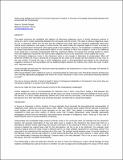| dc.description.abstract | This paper examines the modalities and logistics of refocusing indigenous music in formal classroom practice in Kenya in a bid to create partnership between the community and the school. The need to refocus indigenous music for use in classroom stems from the fact that the childhood and youth when the individual traditionally learnt their cultural music practices is now spent in school hence, the need to take this important aspect of music to school to ensure its preservation among the school going youth in the academy. More so, the breakdown in traditional systems of cultural transmission among modernized nations on the continent of Africa has resulted in much of its traditional music being lost or severely misinterpreted. With the urbanized children not having their working parents to induct them into indigenous musical life, the need to take indigenous music to the classroom is more urgent and crucial.
But introducing indigenous music in the classroom alone is not enough to determine its preservation. What will determine whether the music is preserved or decayed are the mode (s) of transfer and the treatment of this music in the new context. Currently the way in which indigenous music is recontextualised and treated in the classrooms suggests a process of burning bridges and not building bridges between the cultures from where the music is taken and classroom culture.
Using examples derived from the classroom teaching situations and experiences in Kenya, this paper will attempt to answer the following questions:
What should happen when indigenous music is recontextualised for classroom use? Should the teacher develop and use culturally appropriate pedagogies that match the music’s demands or stick to the conventional teaching methods in music?
How do we ensure retention of what is taught in terms of subsequent application in the learners’ lives since they are not going to operate in a vacuum once they graduate?
How do we make the music learnt relevant in terms of the contemporary challenges?
Unless indigenous music is recontextualised for classroom use in such a way that a bridge is built between the cultural practice and classroom demands so that the music can move to and from these two settings for future use by the learners, in a bid to create partnership between the school and the community, it will become a cultural thing that the learners do in their secondary and university education and after that it is dead and forgotten | en_US |

